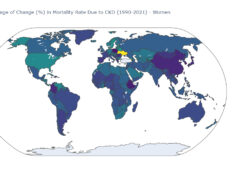 New research presented at the American Society of Nephrology (ASN) Kidney Week (2–7 November 2021, virtual) indicates that substantial discrepancies exist between two major tools used to assess kidney function—estimated glomerular filtration rate (eGFR) and measured glomerular filtration rate (mGFR)—even in an individual patient.
New research presented at the American Society of Nephrology (ASN) Kidney Week (2–7 November 2021, virtual) indicates that substantial discrepancies exist between two major tools used to assess kidney function—estimated glomerular filtration rate (eGFR) and measured glomerular filtration rate (mGFR)—even in an individual patient.
To determine an individual’s kidney function, clinicians evaluate their glomerular filtration rate (GFR), with a GFR of more than 60mL/min/1.73m2 being considered to be in the normal range. GFR can be measured via mGFR, or calculated from creatinine and cystatin C blood levels using an estimating equation—known as eGFR.
A new study, the findings of which were presented at ASN Kidney Week 2021, has found that substantial discrepancies exist between these two assessments. For the study, investigators analysed data from four community-based groups where GFR was assessed as part of research protocols.
“We found that there was a very wide range of mGFR at each eGFR level,” said the study’s corresponding author Tariq Shafi (University of Mississippi Medical Center, Jackson, USA). “For an individual with eGFR calculated as 45mL/min/1.73m2, the mGFR ranged from 28 to 72mL/min/1.73m2.”
This discrepancy was present at all levels of eGFR, the research also indicated, with discrepancies being seen within individual patients too. At an eGFR level of 30mL/min/1.73m2, the mGFR ranged from 19 to 56mL/min/1.73m2. Therefore, some individuals with normal kidney function may be diagnosed with kidney disease based on eGFR, while severe kidney dysfunction may be missed in others.
The discrepancy in eGFR and mGFR within racial groups was also substantially higher than between-group differences. For example, at a calculated eGFR of 60mL/min/1.73m2, the mGFR ranged from 32 to 91mL/min/1.73m2 for Black patients and 37 to 86mL/min/1.73m2 for white patients—substantially larger and overlapping ranges compared to the 5mL/min/1.73m2 group difference between Black and white patients.
“Our results suggest that the eGFR calculation should be reported with the associated range of uncertainty,” added Shafi. “Our results also indicate that, in some instances, clinical decisions may need to be based on measured rather than estimated GFR.”










